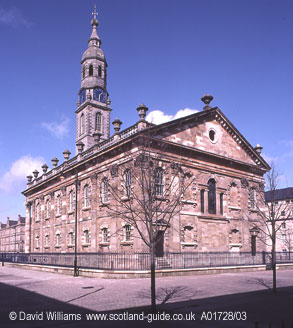The city expanded rapidly in the second half of the eighteenth century due in great measure to the prosperity brought about by the trade in tobacco, sugar and cotton, and many of the richer merchants moved a short distance westwards from the High Street. A number of them became developers and they built on their own land, thus encouraging the emergence of what we now call `The Merchant City`. Glasgow`s gridiron street layout dates from this time and this regular rectangular pattern was maintained as the city expanded westwards. However, this design failed to spread to the east and south of the city because of the growth of industry in these areas and also because of the exploitation of local deposits of iron ore and coal. Speculative `superior` housing developments were started in a number of the city`s peripheral areas, notably Carlton Place (1802-18) and Blythswood Square (1823), and these provided the wealthy with large and comfortable terraced houses. The tall tenement buildings which became so common in most parts of the city were built for a wide range of tenants and most of those we see today were built in the second half of the nineteenth century.
As in many cities, the growth in prosperity was reflected in the construction
of elaborate churches. St Andrew`s Parish Church (1739-56) (see
picture)
was erected in what was then a very fashionable area, though the substantial
houses which surrounded it were built at a later date. In time, a number
of church architects adopted the Gothic style; Thomas Rickman who built
St David`s (Ramshorn Kirk) in 1824-6 is such an example. The early
nineteenth-century public buildings also reflected the growing importance
of the city; amongst the most notable of these are the riverside Custom
House (1840) and the massive County Buildings and Courthouses
(1841-71). In addition, the merchants started to invest huge sums of money
in their own workplaces and imposing buildings such as the Royal Exchange
(1827) were lavishly decorated in order to show off the merchants` wealth
and taste; in comparison, the Tobacco Lords worked from rather
spartan premises.
This article is based on the guidebook "The Glasgow Guide".

It is modelled on St Martin`s-in-the-Fields in London.